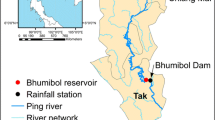Abstract
Based on wavelet analysis theory, a wavelet predictor-corrector model is developed for the simulation and prediction of monthly discharge time series. In this model, the non-stationary time series of monthly discharge is decomposed into an approximated time series and several stationary detail time series according to the principle of wavelet decomposition. Each one of the decomposed time series is predicted, respectively, through the ARMA model for stationary time series. Then the correction procedure is conducted for the sum of the prediction results. Taking the monthly discharge at Yichang station of Yangtse River as an example, the monthly discharge is simulated by using ARMA model, seasonal ARIMA model, BP artificial neural network model and the wavelet predictor-corrector model proposed in this article, respectively. And the effect of decomposition scale for the wavelet predictor-corrector model is also discussed. It is shown that the wavelet predictor-corrector model has higher prediction accuracy than the some other models and the decomposition scale has no obvious effect on the prediction for monthly discharge time series in the example.
Similar content being viewed by others
References
Aussem A, Murtagh F (1997) Combing neural network forecasts on wavelet-transformed time series. Connect Sci 10(1):113–121
Aussem A, Campbell J, Murtagh F (1997) Wavelet-based feature extraction and decomposition strategies for financial forecasting. J Comput Intell Finance 1–17
Box GEP, Jenkins GM, Reinsel GC (1997) Time series analysis: forecasting and control. China Statistic Press, Beijing, China
Chang FJ, Chen YC (2001) A counterpropagation fuzzy-neural network modeling approach to real time streamflow prediction. J Hydrol 245:153–164
Chen SY, Li QG (2004) An areal rainfall forecasting method based on fuzzy optimum neural network and geography information system. 2004 World Congress on Intelligent Control and Automation
Chen SY, Wang W, Qu GF (2004) Combining wavelet transform and Markov model to forecast traffic volume. In: Proceedings of the third international conference on machine learning and cybernetics, Shanghai, pp 2815–2818
Cristea P, Tuduce R, Cristea A (2000) Time series prediction with wavelet neural networks. 5th seminar on neural network Applications in Electrical Engineering, pp 5–10
Hagan M, Menhaj M (1994) Training multilayer networks with the Marquardt algorithm. IEEE Trans Neural Netw 5(6):989–993
Huang W, Xu B, Chan-Hilton A (2004) Forecasting flows in Apalachicola River using neural networks. Hydrol Process 18(13):2545–2564
Islam MN, Sivakumar B (2002) Characterization and prediction of runoff dynamics: a nonlinear dynamical view. Adv Water Resour 25:179–190
Jayawardena AW, Li WK, Xu P (2002) Neighbourhood selection for local modeling and prediction of hydrological time series. J Hydrol 258:40–57
Liong SY, Sivapragasm C (2002) Flood stage forecasting with SVM. J Am Water Resour Assoc 38(1):173–186
Mallat SG (1989) A theory for multi-resolution signal decomposition: the wavelet representation. IEEE Trans PAMI 117:674–693
Raman H, Sunilkumar N (1995) Multivariate modeling of water resources time series using artificial neural networks. Hydrol Sci J 40(2):145–163
Salas JD, Delleur JW, Yevjevich V, Lane WL (1980) Applied modeling of hydrologic time series. Water Resouces Pub, p 484
Sivakumar B, Jayawardena AW, Fernando TMKG (2002) River flow forecasting: use of phase-space reconstruction and artificial neural networks approaches. J Hydrol 265:225–245
Wang WS, Ding J (2003) Wavelet network model and its application to the prediction of hydrology. Nature and Science 1(1):67–71
Yevjevich V (1972) Stochastic process in hydrology. Water Resouces Pub, Colorado
Author information
Authors and Affiliations
Corresponding author
Rights and permissions
About this article
Cite this article
Zhou, Hc., Peng, Y. & Liang, Gh. The Research of Monthly Discharge Predictor-corrector Model Based on Wavelet Decomposition. Water Resour Manage 22, 217–227 (2008). https://doi.org/10.1007/s11269-006-9152-x
Received:
Accepted:
Published:
Issue Date:
DOI: https://doi.org/10.1007/s11269-006-9152-x




